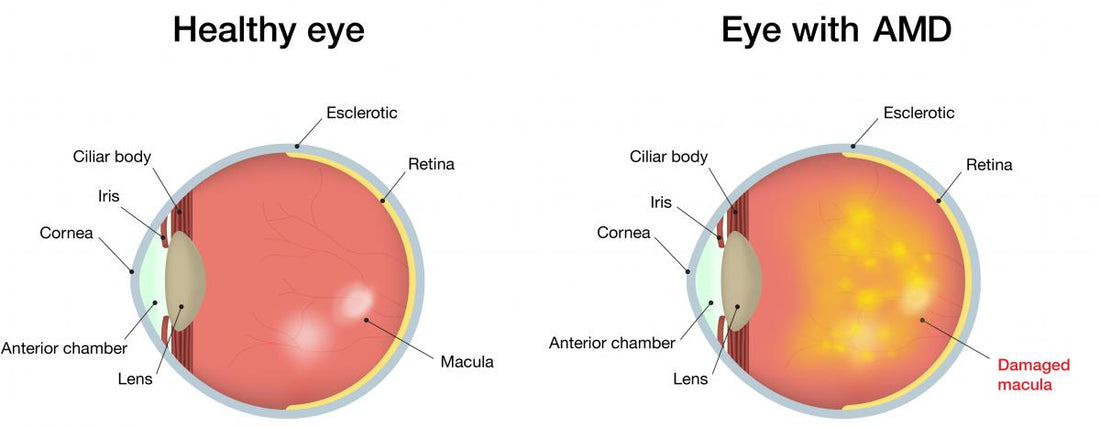
Age-Related Macular Degeneration (AMD)
Share

Age-related macular degeneration (AMD) is a kind of eye disease that causes central vision to fade. It occurs when the macula and straight-ahead vision is damaged as a result of ageing. The macula is a component of the retina which is light-sensitive tissue at the back of the eye. AMD can cause vision loss rapidly or gradually, making it difficult to do tasks that need clear vision, such as reading, sewing, cooking, or driving. It can also make it difficult to see in low light. The good news is that AMD rarely leads to total blindness, as it rarely affects side vision.
Type of Age-related macular degeneration (AMD)

- Dry AMD
People who have this condition may have yellow spots called drusen in their macula. A few tiny drusen may not affect your vision. However, when they get larger and more widespread, they may blur or distort your eyesight, especially when reading. The light-sensitive cells in your macula get thinner and finally die as the disease worsens.
- Wet AMD
Leak blood vessels in the retina produce wet AMD. These abnormal blood veins have the potential to leak fluids or blood into the back of the eye. Wet AMD patients usually have more severe visual loss than dry AMD patients. Wet AMD vision loss is frequently not recognized by the patient until the problem has progressed to a critical stage. Wet AMD can cause abrupt vision loss in rare situations.
Symptoms of AMD
The symptoms of AMD vary according on the stage. Dry AMD manifests itself in three stages: early, middle, and late. Because AMD is a degenerative illness, the symptoms generally worsen over time.
- There are no signs of early dry AMD
- Straight lines become blurred, wavy, or missing
- Color deterioration and/or changes in appearance
- Some persons with intermediate dry AMD have no symptoms. Others may experience minor symptoms such as slight blurriness in their center vision or difficulty seeing in dim light.
If you have any of these symptoms, make an appointment with an eye doctor as soon as possible.

The treatment for AMD is determined on the stage and type. Because there is currently no therapy for early AMD, your eye doctor will most likely simply monitor how your eyes are doing through frequent eye exams. Eating healthily, exercising regularly, and quitting smoking can all help.
If you have intermediate AMD in one or both eyes, specific dietary supplements such as vitamins and minerals may be able to prevent it from progressing to late AMD. If you have late AMD in only one eye, these supplements may help delay the progression of AMD in the other eye.
Early diagnosis is critical. If there is an issue, the doctor may advise you to an eye doctor. Make an appointment with a pediatric eye doctor if you suspect something is amiss with your eyesight, even if nothing is revealed by the vision test. You can drop by to our shop at Malaya Optical Optometrist if you just nearby Petaling Jaya area to check your eyes. If you interested to wear contact lenses, you can just purchase contact lenses online through our website at shop.malayaoptical.com
